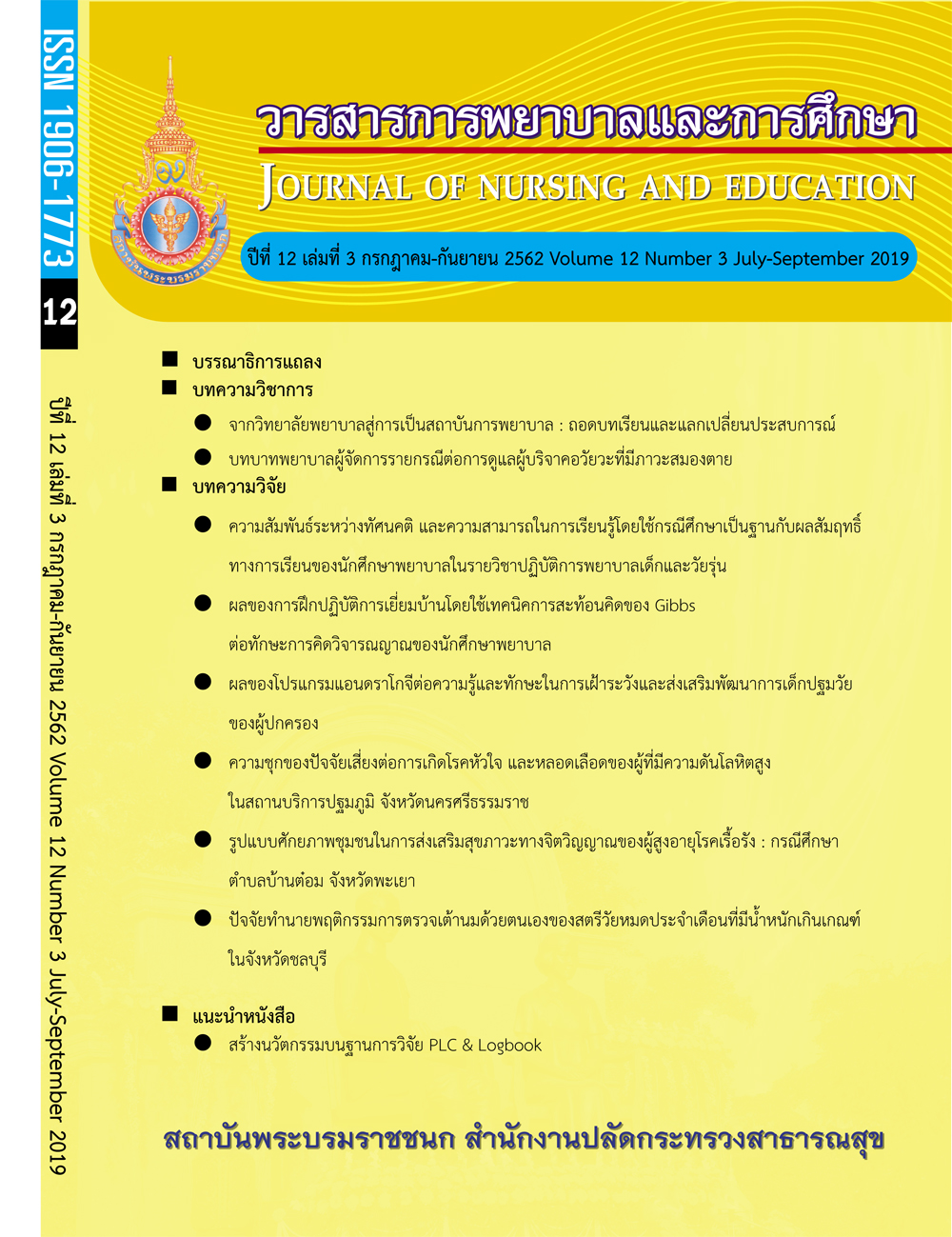ความชุกของปัจจัยเสี่ยงต่อการเกิดโรคหัวใจ และหลอดเลือด ของผู้ที่มีความดันโลหิตสูงในสถานบริการปฐมภูมิ จังหวัดนครศรีธรรมราช
Prevalence of Risk Factors for Cardiovascular Disease among Hypertensive Patients in Primary Care Unit in Nakhon Si Thammarat
คำสำคัญ:
ความชุก, ปัจจัยเสี่ยงของโรคหัวใจและหลอดเลือด ค, ความดันโลหิตสูง, การศึกษาข้อมูลทุติยภูมิบทคัดย่อ
บทคัดย่อ
การวิจัยเชิงบรรยาย เพื่อศึกษาความชุกของปัจจัยเสี่ยงต่อการเกิดโรคหัวใจและหลอดเลือด ในผู้ที่มีความดันโลหิตสูงจำนวน 302 ราย ที่มารับการรักษาในโรงพยาบาล ส่งเสริมสุขภาพตำบลแห่งหนึ่ง ในจังหวัดนครศรีธรรมราช โดยเก็บข้อมูลจากเวชระเบียนย้อนหลัง 1 ปี วิเคราะห์ข้อมูลโดยใช้สถิติ chi-square test และคำนวณค่า crude odd ratio ที่ระดับช่วงความเชื่อมั่น 95% ผลการวิจัยพบว่า ความชุกของปัจจัยเสี่ยงต่อการเกิดโรคหัวใจและหลอดเลือด โดยแยก ตามเพศ และการคำนวณอิทธิพลตามการถ่วงน้ำหนักของ Global Risk Assessment Scoring พบว่า ปัจจัยเสี่ยงมีความชุกแตกต่างกันระหว่างสองเพศ โดยเพศหญิง พบปัจจัยที่มีความชุกสูงคือการป่วยเป็นโรคเบาหวาน และระดับคอเลสเตอรอลสูง ส่วนในเพศชาย คือระดับความดันโลหิตซิสทอลิก และการสูบบุหรี่ กลุ่มตัวอย่างมีระดับความเสี่ยง ต่อการเกิดโรคหัวใจและหลอดเลือด อยู่ในระดับสูงร้อยละ 42.0 ระดับปานกลาง ร้อยละ 52.0 ระดับต่ำร้อยละ6.0 เมื่อแยกระดับความเสี่ยงออกเป็น 2 กลุ่มคือ กลุ่มเสี่ยงต่ำถึงเสี่ยงปานกลาง และกลุ่มเสี่ยงสูง พิจารณาแยกตามเพศพบว่า ระดับความเสี่ยงต่อการเกิดโรคหัวใจและหลอดเลือด มีความแตกต่างกันอย่างมีนัยสำคัญ โดยเพศชายมีระดับเสี่ยงสูงถึงร้อยละ 81.1 ส่วนเพศหญิงมีระดับเสี่ยงสูงร้อยละ 25.5 ปัจจัยเสี่ยงหลักที่มีความสัมพันธ์กับความเสี่ยงต่อการเกิดโรคระดับสูง อย่างมีนัยสำคัญทางสถิติในเพศชายคือ ปัจจัยด้านอายุและการสูบบุหรี่ โดยเพศชายอายุ 60 ปีขึ้นไป มีโอกาสอยู่ในกลุ่มเสี่ยงสูงเป็น 7.6 เท่าของกลุ่มอายุน้อยกว่า และผู้ที่สูบบุหรี่ มีโอกาสอยู่ในกลุ่มเสี่ยงสูง 5 เท่าของผู้ไม่สูบบุหรี่ ส่วนในเพศหญิงปัจจัยเสี่ยงหลัก ที่มีความสัมพันธ์กับความเสี่ยงต่อการเกิดโรคระดับสูงอย่างมีนัยสำคัญทางสถิติ คือการป่วยเป็นโรคเบาหวาน โดยเพศหญิงที่ป่วยเป็นโรคเบาหวาน จะมีโอกาสอยู่ในกลุ่มเสี่ยงสูง 4.4 เท่าของผู้ไม่เป็นโรค ส่วนปัจจัยเสี่ยงร่วมพบว่า เพศหญิงที่มีไขมันไตรกลีเซอไรด์สูงเกิน 150 มก./ดล จะมีโอกาสอยู่ในกลุ่มเสี่ยงสูงเป็น 2 เท่าของผู้ที่มีระดับไขมันปกติ ผลการศึกษาแสดงให้เห็นว่า ความชุกของปัจจัยเสี่ยงต่อการเกิดโรคหัวใจและหลอดเลือด มีความแตกต่างกันระหว่างเพศชายและเพศหญิง ดังนั้นการวางแผนกิจกรรมการป้องกันโรค ควรมีความเฉพาะเจาะจงตามความชุกของปัจจัยเสี่ยงแยกตามเพศ
เอกสารอ้างอิง
1. Benjamin EJ, Blaha MJ, Chiuve SE, Cushman M, Das SR, Deo R, et al. Heart disease and
stroke statistics—2017 update: a report from the American Heart
Association.Circulation. 2017; 135:e146–603.
2. International Health Policy Program-Thailand: The study of burden of diseases in
Thai population in 2014. Nontabury: The Graphico systems co.,ltd.; 2017. (in Thai)
3. D'Agostino R, Pencina M, Massaro J, Coady S. Cardiovascular Disease Risk Assessment:
Insights from Framingham. Global Heart. 2013;8(1):11-23.
4. Alberti KG, Eckel RH, Grundy SM et al. Harmonizing the metabolic syndrome: a joint interim statement of the International Diabetes Federation Task Force on Epidemiology and Prevention; National Heart, Lung and Blood Institute; American Heart Association; World Heart Federation; International Atherosclerosis Society; and International Association for the Study of Obesity. Circulation. 2009; 120: 1640–1645.
5.Karmali KN, Lloyd-Jones DM. Global Risk Assessment to Guide Blood Pressure Management in Cardiovascular Disease Prevention. Hypertension. 2017;69(3): e2–e9.
6. Goff DC, Lloyd-Jones DM, Bennett G, et al. 2013 ACC/AHA Guideline on the assessment of cardiovascular risk: A report of the American College of cardiology/American heart association task force on practice guidelines. J Am Coll Cardiology.2014; 63: 2935-59.
7.Alshehri AM. Metabolic syndrome and cardiovascular risk. J Family Community Med.2010;17(2):73–78.
8. Bitton A, Gaziano TA. The Framingham Heart Study's impact on global risk assessment.
Prog Cardiovasc Dis. 2010;53(1):68–78.
9. Yip W, Wong TY, Jonas JB, et al. Prevalence, awareness, and control of hypertension among Asian Indians living in urban Singapore and rural India. J Hypertens 2013;31:1539–46.
10.Liew SJ, Lee JT, Tan CS, et al. Sociodemographic factors in relation to hypertension prevalence, awareness, treatment and control in a multiethnic Asian population: a crosssectional study. BMJ .2019; 9:e025869.
11. Wu J, Li T, Song X, et al. Prevalence and distribution of hypertension and related risk factors in Jilin Province, China 2015: a cross-sectional study. BMJ Open. 2018;8(3): e020126.
12. Weycker D, Nichols G, Okeefferosetti M, Edelsberg J, Khan Z, Kaura S, et al. Risk-Factor
Clustering and Cardiovascular Disease Risk in Hypertensive Patients. American Journal
of Hypertension. 2007;20(6):599-607.
13. Keto J, Ventola H, Jokelainen J, et al. Cardiovascular disease risk factors in relation to smoking behaviour and history: a population-based cohort study. Open Heart. 2016;3(2): e000358.
14. Ukena, C., Mahfoud, F., Kindermann, M., Graber, S., Kindermann, I., Schneider, M.,… Bohm, M. Smoking is associated with a high prevalence of microalbuminuria in hypertensive high-risk patients: Data from I-SEARCH. Clinical Research in Cardiology.2010; 99(12): 825-832.
15. The IDF consensus worldwide definition of the metabolic syndrome. International Diabetes Federation 2005; Brussels: Belgium.
16. Sallam T, Watson KE. Predictors of cardiovascular risk in women. Womens Health (Lond). 2013;9(5):491-8.






